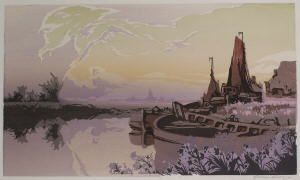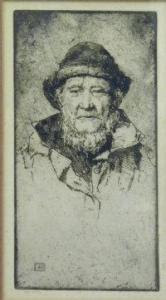Else Zinkeisen
(born 1871 Hamburg)
German woodblock printmaker.
(I): River Elbe
Today, again, an Ebay induced posting on a printmaker I’d never heard of before leading to
some great discoveries and other fine artists. This above “Boote bei Sonnenuntergang”
(Boats at sunset) undoubtedly are sailing in the Elbe estuary and came up for auction recently.
"Fischer Boote auf der Elbe" and "Wolken über der Elbe".
Other than
the fact Else Zinkeisen was taught privately until 1899 and that she has
been a member of the “Heikendorfer Künstlerkolonie” my research turned up absolutely nothing. But luckily a small but fine collection of her prints is kept in the “Künstlermuseum Heikendorf" at the Kieler Förde.
Left: Else Zinkeisen, Right: Oscar Droege, (same?) dwellings along river Elbe.
The Kieler Förde, an inlet of the Baltic sea, North West of Hamburg in Germany's most Northern and beautiful province of Schleswick-Holstein. Sheltered and strategically situated along the busy trade route between North-Western Europe, Scandinavia, Denmark and the Baltic States. Not one of these prints I could locate outside this Museum: a well hidden treasure of prints of what has to be one of the earliest German Modern Printmakers.
The Elbe River downstream North of Hamburg seen from the Ice-age,
glacier formed East bank ridge by Friedrich Kallmorgen (1856-1924)
Man made Elbe dikes by painter Friedrich Wilhelm Schwinge (1852-1913)
The artist
colony sprang up in the 1920's around the house and studio of painter Heinrich Blunk (1891-1963) and it is one of the very few buildings remaining after WWII devastations. Kiel and its
surroundings, like Hamburg in 1943, was almost completely destroyed by allied
bombs because of its marine and submarine bases. The artists’ studios are gone
but the House and Gardens survived, now housing the Museum.
Where we meet
another great member of the colony: Oscar Droege (1898-1983) also born in Hamburg (but 25 years after Else Zinkeisen) and perhaps Germany’s
most famous and certainly most prolific printmaker. Many of his (I count over a 100) prints featuring Hamburg and the river Elbe.
Painter
Georg Burmester (1864-1936) was among them, very much influenced by Vincent van Gogh and later to become a professor in Kassel art
academie. He painted the surrounding
Schleswick land- and seascapes

 Along the North
German coast, to the East the sister "Niddener Künstkolonie" thrived. You can find
similar prints of typical Baltic fishing and trading boats by members Margarethe (L.E.M.) Gerhardt (1873-) and Daniel Stachsus (1872-1953). Max Pechstein and Lovis Corinth lived there.
Along the North
German coast, to the East the sister "Niddener Künstkolonie" thrived. You can find
similar prints of typical Baltic fishing and trading boats by members Margarethe (L.E.M.) Gerhardt (1873-) and Daniel Stachsus (1872-1953). Max Pechstein and Lovis Corinth lived there.
This print by
Else Zinkeisen is showing river fishing boats in the small tranquil village and fishing port of Altweder. Just opposite, on the other (West) side of river Elbe, of the mighty city of Hamburg. And situated in a wonderful ancient and rural landscape. Below a photograph from about the time Else was there.
A situation painted (below) by Friedrich Wilhelm Schwinge (1852-1913), my
favorite painter of the Frisian and Schleswick landscape (see also above).
And as it was recorded in one of the very last moments of it's existence (above) on photo. The fate that struck the village of Altweder has frightful similarities with the Dutch village of Blankenberg (50 years before) I wrote about in my earlier posting: Blankenburg (link). It's the inevitabillity of progress: it can’t be stopped. It's all gone. Forever.
The
Scottish sisters and artists Anna and Doris Zinkeisen are not (directly) related
to Else. Anna Zinkeisen who designed several London Underground posters in the 1920-30’s and her Scottish family of timber traders have a 200 year
Scottish history leading back to Silesian ancestry.
Next: some more prints and history by Else Zinkeisen.



































.jpg)

















